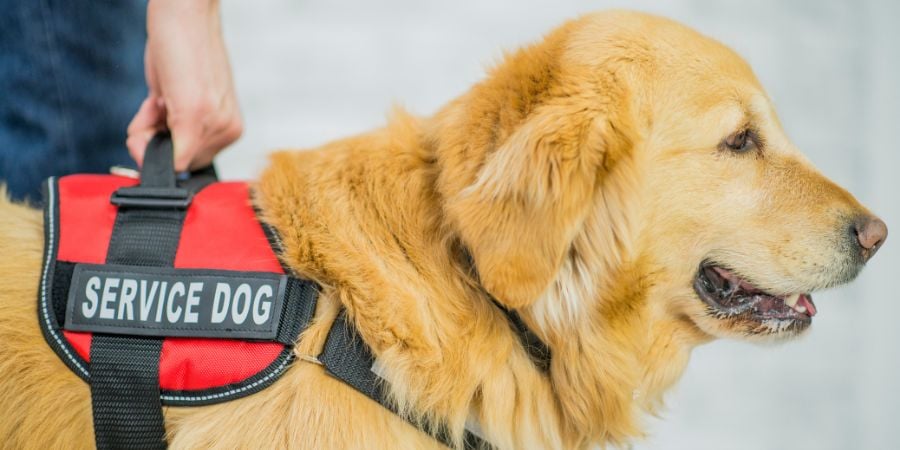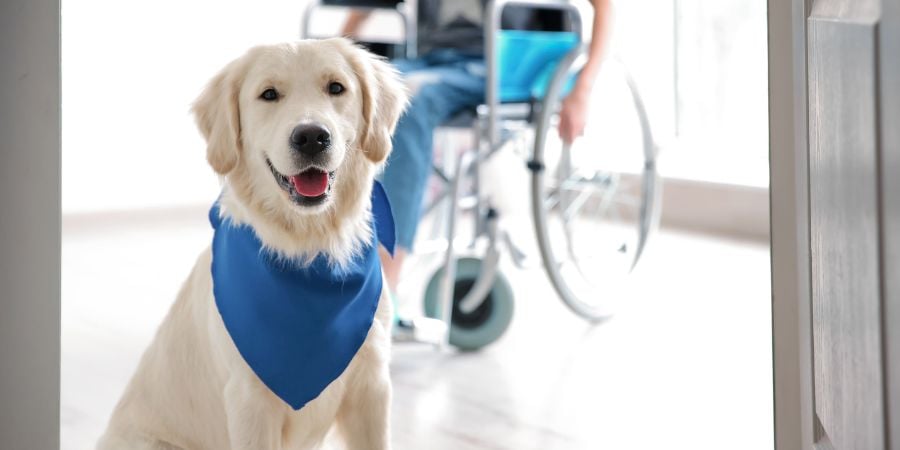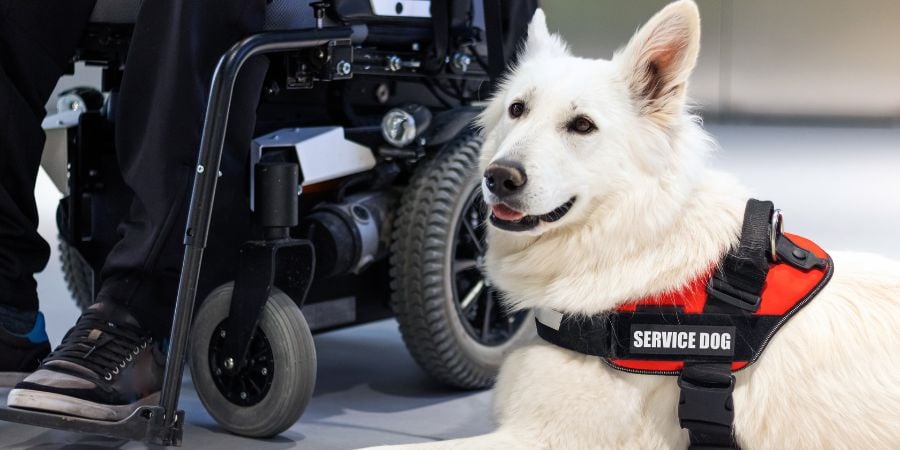Support Service Dogs 101 — Everything You Need to Know
by Dakota Storage Buildings, on December 26, 2023

Service dogs are heroes, trained meticulously to support individuals with disabilities, ranging from visual and hearing impairments to mental health and mobility issues. Their presence can mean the difference between dependence and a life of increased autonomy. If you are considering training a k-9 police dog or a service dog or are curious about what this entails, you have come to a junction of commitment, patience, and knowledge. In this guide, we will delve into the suitable breeds for service work, the nuances of their training, and how to maintain their well-being on and off duty. Remember, embarking on this journey requires extensive research beyond this starting point to ensure your dog is primed to aid those in need.
Service Dogs 101: Defining Their Roles and Understanding Their Impact
Service dogs are a testament to the unique bond between dogs and humans, serving as an extension of their handlers' capabilities and fostering a sense of independence that might otherwise be out of reach. These dogs are not pets; they are highly trained assistants capable of performing tasks that range from opening doors to providing life-saving interventions. To truly understand the value of a service dog, one must comprehend the full spectrum of tasks they can perform.
Guide dogs for the blind are perhaps the most recognized service dogs, navigating their handlers through the complexities of daily life. However, service dogs wear many hats — they can be ears for the deaf, providing alerts to sounds, or they can be a comforting presence, warding off the crippling effects of PTSD in psychiatric service work. Beyond their physical capabilities, service dogs are emotional anchors for their handlers. Their presence can alleviate anxiety, provide comfort in overwhelming social situations, and offer an unspoken understanding that often transcends human interactions. They are not just assistants; they are lifelines for many.
In terms of personality, the ideal service dog possesses a specific set of traits. They must be intelligent, which allows them to learn and perform a wide variety of tasks. They should also exhibit a calm temperament, ensuring they remain focused and unperturbed in high-stress or distracting environments. Dependability is critical — these dogs must perform their tasks reliably, especially when they are matters of safety or health. They should also not be easily startled and must display an even keel in both quiet and chaotic settings.
Popular Breeds: The Canine Elite in Service Work

When selecting a service dog, the breed is a significant consideration, as certain breeds possess traits that make them more suited to the demands of service work. These breeds have been recognized not only for their physical attributes and intelligence but also for their emotional intelligence and ability to bond with humans. Let’s delve into the attributes of some of the most popular breeds in service work.
Labrador Retriever
The Labrador Retriever stands as a perfect example of service dog breeds, frequently topping the list due to its blend of intelligence, patience, and gentle demeanor. Originally bred as a hunting dog, the Lab’s keen ability to follow commands and desire to retrieve translate seamlessly into the realm of service. They are innately sociable, which helps them interact positively with humans and other animals alike — a crucial trait for a dog that must navigate public spaces regularly.
Their eagerness to please makes them excellent candidates for tasks that require a high degree of obedience and adaptability. Whether it is navigating a crowded street, retrieving dropped items, or pressing an alert button, Labs approach their tasks with affable diligence that makes them reliable and effective service dogs.
Golden Retriever
Golden Retrievers are another breed synonymous with service and assistance roles. They share many of the favorable traits of the Labrador, including a friendly nature and an impressive capacity for training. Goldens have a slightly more sensitive nature, which can be an asset in tasks that require detecting subtle changes in a handler's mood or health.
Their long, flowing coats require regular grooming, which can be a therapeutic ritual for some handlers, further enhancing the bond between dog and owner. Goldens are also known for their patience and are particularly good with children and the elderly, making them versatile for a range of service roles, including therapeutic settings.
German Shepherd
The German Shepherd brings an air of confidence and versatility to the field of service work. Historically used for herding and protection, their courage and keen sense of duty make them exemplary in roles that require a protective presence. Their intelligence and trainability have made them a mainstay in police and military roles, often referred to as a "police dog," which demonstrates their capability in rigorous tasks.
In service work, German Shepherds are particularly suited to mobility assistance and PTSD support. Their alertness and loyalty mean they are quick to respond to their handler's needs, while their steady nature can provide a calming influence. The same attributes that make them effective as police dog also contribute to their reliability in various service capacities, ensuring they can be trusted in critical roles for their handlers.
Poodle
Poodles, often underestimated due to their stylish looks, are in fact one of the most intelligent breeds. They excel in obedience training, which is fundamental in service work. Their hypoallergenic coats make them suitable for individuals with allergies, a trait not to be overlooked when a service dog is a constant companion.
Standard Poodles have a dignified and gentle manner but do not let that fool you — they are also astute and lively, capable of learning a variety of tasks with the right training. Their sensitivity to their handler’s needs makes them excellent at detecting medical alerts and providing emotional support.
Each of these breeds brings a unique set of strengths to service work, but they share common traits: intelligence, trainability, and a stable temperament. The best breed for a service dog often depends on the specific needs and circumstances of the handler. While these breeds are popular, they are not the only ones capable of performing service work. Many mixed breeds and less well-known purebreds also make excellent service dogs. The key is to match the individual dog’s temperament, size, and energy level with the handler's requirements.
Training Service Dogs for Success

To say that a service dog’s training is rigorous would be an understatement. Their training covers basic obedience, of course, but it extends far beyond that. These dogs are trained to perform complex tasks tailored to their future handler’s specific needs. For example, a dog may learn to detect the onset of a medical issue such as a diabetic low or an epileptic seizure and to alert their handler or even seek help. This requires not only intelligence and skill but also a deep-seated bond between the dog and its handler forged through trust and consistent, positive reinforcement.
Before a dog can specialize in service tasks, it must master basic obedience. This foundational training creates a common language between dog and handler, crucial for further training. Commands such as "sit," "stay," "come," and "heel" are the bedrock upon which all other skills are built. However, service dogs must perform these with a degree of reliability and precision that goes beyond the average pet dog's abilities. Just as a police dog is expected to perform under varied and often challenging conditions, so too must a service dog be ready to meet the needs of their handler in any situation. Task training is where the real specificity of service dog work comes into play. These life-saving skills are taught through repetitive training and positive reinforcement, often with the aid of professional trainers who specialize in medical alert work.
Beyond performing specific tasks, service dogs must be adept at navigating the human world. Public access training teaches them how to behave impeccably in various settings such as restaurants, shopping centers, theaters, and on public transportation. They must remain calm and focused despite distractions like traffic, crowds, or other animals. This part of training is vital because a service dog’s behavior must be beyond reproach in public. Any disruptive behavior could lead to the dog and handler being asked to leave a public space, which can be detrimental to the handler who relies on their service dog’s assistance.
A service dog’s training also heavily emphasizes socialization. From a young age, these dogs are exposed to a variety of people, environments, sounds, and textures. This exposure ensures that they are comfortable and confident in a wide range of situations and less likely to be startled or react negatively to new experiences. It is crucial for a service dog to maintain composure and attentiveness to their handler, regardless of what is happening around them.
Training a service dog is a nuanced and ongoing process that must be approached with patience, consistency, and a deep understanding of the dog’s psychology and learning processes. It’s a journey that demands commitment from both the handler and the dog but results in a partnership that enhances independence and quality of life for individuals with disabilities.
Cultivating a Well-rounded Service Dog Through Socialization
Socialization and continued enrichment are vital components of a service dog’s development and well-being. These processes are not just about exposure; they are about cultivating a dog that can navigate the world with confidence and poise, providing support to their handler in numerous situations. Socialization is how a puppy learns to identify and interact with its environment, including people, other animals, places, and experiences. For service dogs, this process is carefully structured to ensure they are comfortable and confident no matter where their duties may take them. It is not merely about meeting new people or dogs; it is about ensuring that these encounters are positive and that the dog learns appropriate behaviors in a variety of settings.
Puppies destined to become service dogs are often introduced to new experiences in a controlled manner. Trainers may take them to different parts of a city and expose them to sounds of traffic, crowds, and unfamiliar objects like wheelchairs or crutches. These experiences teach them not to fear or overreact to new stimuli, which is essential for a dog who will work in public spaces.
Service dogs, like all dogs, need mental stimulation to stay sharp and content. Enrichment activities can prevent boredom and mitigate stress, leading to a healthier, happier dog. Enrichment can take many forms:
Puzzle Toys: These can be excellent tools for service dogs. Working to remove treats from a puzzle toy can provide mental stimulation on days when their work does not.
Games: Using their keen sense of smell in games such as scent work or finding hidden treats can be both enjoyable and cognitively challenging for the dog.
New Commands: Learning new commands or tricks is not just for impressing friends; it keeps the dog’s mind active and engaged.
Interactive Play: Playing with other dogs or humans in a safe, controlled environment allows service dogs to relax and enjoy being just a dog for a while.
For service dogs, the line between work and play should be well-defined, but flexible. They need to understand when it is time to work and when it is okay to relax and play. Handlers can help with this by using specific gear (like a service dog vest) to signal when it is time to work and having clear cues for when it is time to unwind. During downtime, service dogs must engage in normal dog behaviors. Regular play sessions and leisure walks are important, as they allow the dog to expend energy and simply enjoy being a dog. This balance prevents burnout and keeps the dog keen and motivated for their important work.
Fostering Excellence in Service Dogs
Training a service dog demands more than the usual obedience drills. It is a journey filled with challenges and triumphs, requiring dedication, understanding, and an enduring commitment to excellence. Techniques can be instrumental, but the key lies in consistent practice and reinforcement. It is essential to establish a clear communication channel with your dog, positioning yourself as a leader they can trust and follow. For those ready to start this remarkable journey, remember: the foundation of a great service dog lies not just in the training it receives but also in the continuous care, respect, and mutual trust fostered between the dog and the handler. Download our free resource, “How to Ensure Your Working Dog is Healthy & Happy,” seek out reputable resources, connect with communities, and step into the world of service dog training well-prepared.

























